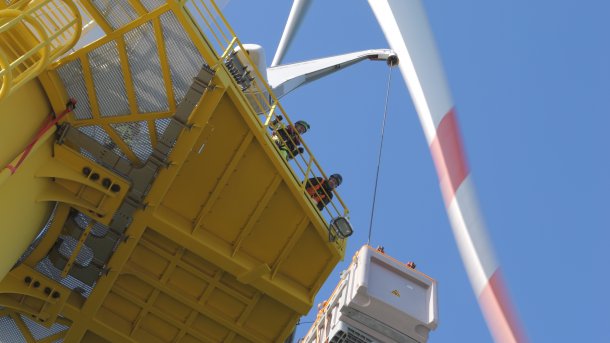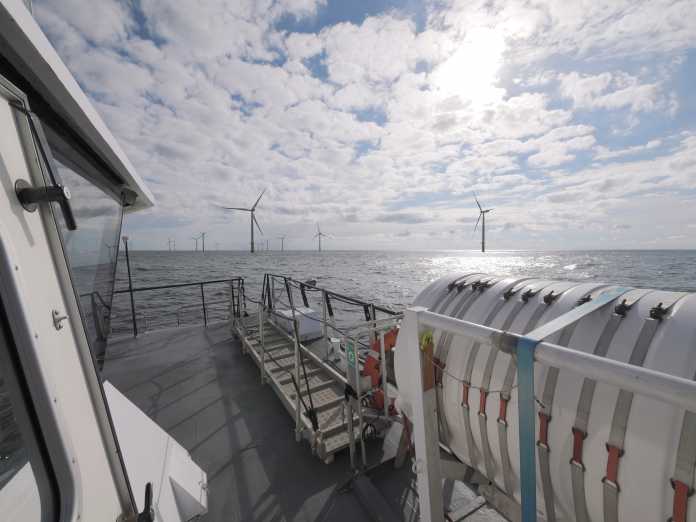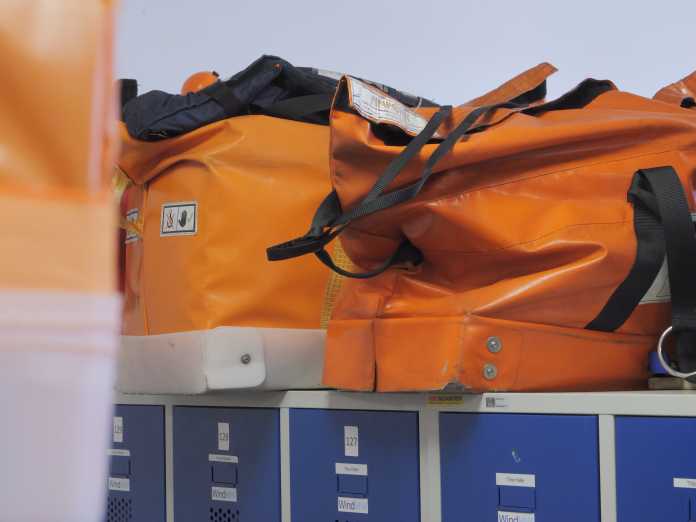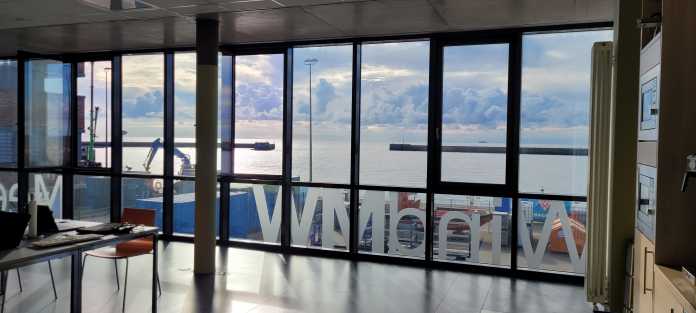Wind power jobs: The offshore service technician - the way is the way round
With classic apprenticeships such as electrician or mechatronics technician, it is also possible to work offshore. But you also have to be tough for this job.

(Bild: heise online/Johannes Börnsen)
(Hier finden Sie die deutsche Version des Beitrags)
In Germany and Europe, there is concern about a blackout in the face of ongoing discussions about energy shortages as a result of Russia's war of aggression on Ukraine. Depending on how one looks at it, the energy transition in Germany is considered to have been delayed or even to have failed. In many places, horror scenarios are being sketched out.
We decided to look ahead and take a closer look at what is considered one of the big factors for the success of the energy transition: offshore wind power. To get a closer look at what is actually happening, installed and maintained offshore, we visited WindMW GmbH, which operates on Helgoland as well as in Bremerhaven and Zossen.
This series of articles comprises several parts, which we publish from Tuesday to Friday this week.
Published so far:
- Offshore wind power - a building block for energy independence
- Interview on offshore wind power: "It's a huge challenge".
The training profession "offshore service technician" does not yet exist. As a rule, the employees of WindMW Service GmbH have therefore gained previous experience in other professions or have completed classical training in other areas and have then come to wind power.
Tomasz "Tomek" Sroka, for example, is actually a qualified mechatronics technician and, after training in the automotive sector, worked for onshore wind turbines for quite a while. He is currently undergoing three months of IHK-recognised further training to become an electrical engineering specialist for wind turbines, which is paid for and supported by WindMW. Other employees used to work on onshore platforms for fossil fuel production and now work in the transformer station or the turbines.
Service technician Tomek literally took us by the hand during the first hours at the WindMW station and showed us the offices, common rooms, changing rooms and also the WindMW warehouse. Meanwhile, he told us a lot about his employer.
Permit to entry – not denied
Around 50 people work for WindMW Service GmbH on Helgoland. Many industrial electricians are employed by WindMW, but warehousemen and logisticians are also needed, because it is not possible to simply work at sea. For safety reasons, a "permit to enter" is issued for everything, and warehousing and precise loading of the service ships, which are also limited in space, also play an important role.
The company's own warehouse on Helgoland contains the most important and most common spare parts, greases and oils, but everything that is needed on Helgoland always has to pass through customs. Accordingly, the warehouse staff and other employees try to estimate very precisely what might soon be needed again on site.
(Bild: heise online/Kristina Beer)
The higher management level takes care of the safe processes in the daily work of the employees and the safety of the technical facilities. At the head office and among the administrative employees, it is precisely noted which service technician has which skills - for which work he or she is quasi cleared.
For the organisation, as it is simplified locally, a kind of "SAP" is used for offshore companies. From the control centre, the software can be used to see exactly where which technician is currently on duty. And the control room in Bremerhaven also receives this data in 24/7 service to know what is happening at sea - for example, to coordinate emergency operations.
Ships always report to the control room when they are in the 500-metre zone around the wind farm. Ships longer than 24 metres are not allowed to enter the park (except for authority ships). The in-house IT department takes care of the remote monitoring (Scada) and also the Tetra radio.
Work at sea is usually done in teams of three, as this is also an external safety recommendation. The colleagues must be able to rely on each other, stand by each other during shifts and should not have any problems providing first aid in an emergency. If there are more serious injuries, the victims have to be flown out to the mainland by helicopter. The helicopter must be at the site within 30 minutes and should also return to the mainland within 30 minutes.
Due to the special situation, all technicians have extended first aid training. Rescue from confined spaces is also specially trained in advance. And tele-medicine is also available for emergencies.
Off to the park
Before they leave for the parks early in the morning, tools and spare parts have already been packed the day before by warehouse staff on the basis of the to-do lists prepared beforehand. And the technicians also pack their food and their own equipment into a personal bag, which is picked up by the warehouse staff. These things are then loaded onto one of the company's ships and later taken to the actual site of operation at the turbines via the lifting cranes on the transition pieces.
For safety reasons, the technicians do not simply stand on the ship, grab two or three tools and then climb up the wind turbine. That would be too dangerous, because even stepping over to the wind turbine poses some dangers.
With offshore service technicians at sea (17 Bilder)

So the respective captain of the ships tries to dock carefully to the lower steel tube of the windmill. With soft rubber lugs, the ship then bumps against a ladder secured with protruding struts on the transition piece.
The technicians wait on deck for a signal from the crew and then climb up the ladder from deck - while the ship is sometimes more or less moving up and down. If suddenly a big wave comes that lifts the ship more, the climbers have to pull themselves close to the ladder before they can climb further. At the same time, they already secure themselves - as in a climbing park - on holding ropes attached to the turbine.
The own securing on holding constructions continues again and again on the layout. As Johannes was able to observe live, however, even crossing over to a transition piece is a small adventure.
Fit for Windkraft
Since even these safety systems are not infinitely loadable, a maximum weight of 120 kilograms is prescribed for employees at the wind turbines. In addition, the employees' fitness is checked regularly. After all, in addition to the physical exertion involved in the work and, for example, the climbs on the turbines, the technicians also face climatic challenges.
Heat sometimes accumulates in the wind turbines, workers stay on the TPs during the day, they can be exposed to high solar radiation or even great cold.
Empfohlener redaktioneller Inhalt
Mit Ihrer Zustimmmung wird hier ein externes YouTube-Video (Google Ireland Limited) geladen.
Ich bin damit einverstanden, dass mir externe Inhalte angezeigt werden. Damit können personenbezogene Daten an Drittplattformen (Google Ireland Limited) übermittelt werden. Mehr dazu in unserer Datenschutzerklärung.
As the site manager explains, there have already been cases where workers did not meet the health requirements. They then had to work on their fitness again. Only then were they allowed to return to work.
When asked whether - as in other craft enterprises - this results in an earlier retirement age, since health does not always play along until the age of 65 or 67, they nod. The individual case decides, but if the necessary fitness is lacking, technicians may also have to reorient themselves late in their careers.
In the case of WindMW, for example, this means that an older employee has now found a new job at the head office in Bremerhaven. Whether this is still an option for every person who has experienced working at sea is questionable. However, experienced electricians should not run out of work on land with increasingly more decentralisation of energy generation and also increasing electrification of processes.
Not everything from a single source
Some trades are carried out by subcontractors. For example, the diving work to check the condition of the turbines underwater. On Helgoland we also meet a crew that is only responsible for inspecting and repairing rust spots on the turbines. These workers are then often only "on site" for a few months, as they cannot continue with their work in winter. Then the sea is too rough, the storms are too violent. These workers come from companies on land and work onshore and offshore in half-yearly rhythms.
Work at sea has to be oriented to the tides and also the weather conditions anyway. As a result, much more can often be done in summer than in winter. heise online was also advised to still visit in summer.
(Bild: heise online/Kristina Beer)
One of the many research projects surrounding wind turbines deals with this problem, among others. Some operations are so dangerous and costly that the aim is to use sensors and commercially used drones to limit the number of trips for people or at least make them more accurate. However, Dr Holger Huhn also explained to us in the interview that the experiments with drones have produced rather less good results.
The turbines already have some sensor technology - they can also react independently to wind strengths and wind directions on the software side - but if something is broken that has not yet been integrated into the technical monitoring, people have to detect and report faults and damage.
Offshore - Reliability through clear shift schedules
While it also seems reasonable to assume that people need to be on assembly more often for offshore wind power, this is mostly less thought of for onshore. However, this is a fallacy. Both service technician Tomek and other employees of the company have previously worked onshore; Tomek in Germany, Volker and others from the team, however, for example, also abroad, including Canada, Australia, Japan, to install onshore wind turbines over several weeks.
According to Tomek, onshore work in particular was less plannable than his current job. At WindMW, there are crystal-clear two-week shift schedules for most employees. People work two weeks straight and then have two complete weeks off. For the service technicians, this means that 15 of them are on Helgoland for each two-week shift. Due to the clear division, the work schedules are already fixed until summer 2023.
Although the warehouse staff are currently still working one-week shifts, this will soon be changed to two-week shifts in order to improve team coordination on the one hand, but also to become more attractive for employees who do not want to go through the sometimes time-consuming journey to and from Helgoland every week. Antje, the office worker, is an exception in the WindMW job structure. She has a rather classic 9-to-5 job from Monday to Friday, living on the island. She is therefore a colleague who is available on site almost all the time.
In order to facilitate the organisation of work in the shift system, all employees meet "on site" for a "crew change appointment". There they learn what has been done in the past days and what needs to be done soon.
(Bild: heise online/Kristina Beer)
Tomek likes the reliability that the job currently offers him, he says. Onshore, he has had completely different experiences in some cases. Often he was away spontaneously for three or four weeks at a time, although less was planned. Sometimes there was a last-minute call: "Hey, there's something not ready yet - can you please...?", and so his free time became increasingly unplannable.
As he tells it, this had a very negative effect on his private life. Friends could no longer keep track of his days off. Invitations diminished and eventually stopped. In any case, his "free time" simply melted away now and then under some overtime. This is another reason why he is extremely satisfied with his current job.
The four-star accommodation
The living situation is comfortable for WindMW employees on Helgoland. They have an entire hotel at their disposal. The Hotel Atoll in the centre of Unterland, which also once won a design competition and resembles a lagoon inside, was leased for the employees in the early years. In 2019, WindMW bought the four-star hotel. This hardly changed anything for the employees, but not all Helgolanders liked the takeover. However, this way, even through the rather meagre winter, there is always someone on the island who can also consume.
By taking over, employees can also stow away some of their belongings for the time they are not on the island. The sometimes sad "living out of a suitcase" in impersonal hotel rooms can thus be somewhat alleviated.
WindMW - The service technicians on Helgoland (13 Bilder)

Apart from the extravagant design of the lobby, the former Hotel Atoll also offers its employees a few extras. There is a small swimming pool, a sauna and a training room where even cycling, which is otherwise only allowed on Helgoland with special permission, is possible.
To get around Helgoland a bit faster than on foot, you either have to be allowed to drive one of the little Helgoland tuktuks (we had to call them that, it just seemed so obvious) at the permitted 10 km/h, or resort to a pedal scooter, which looks like a child's scooter after the administration of growth hormones. It's a funny design, but sometimes people like to use it. These scooters are available for WindMW staff to borrow at the station. However, again only to a limited extent, as permission must be obtained for this as well.
(Bild: heise online/Kristina Beer)
A video call is also possible offshore
Since Tomek, for example, now also has a wife and two small children on the mainland, he greatly appreciates another circumstance that has nothing to do with fixed working hours or accommodation - it is the now good accessibility despite working remotely. Whereas "being on assembly" used to mean weeks of radio silence, employees can now have daily video calls or phone calls. It is a relief that is very noticeable to some people on site.
Even on the high seas, technicians can keep in touch with their families. So while they fetch the lunch they have prepared themselves from their bags on a transition piece, they can also have a video chat with home. For security reasons, they are not allowed to access the facilities' Wi-Fi, so as not to make them more easily accessible to hackers.
WindMW's wind turbines were also not affected by the disruption of the KA-SAT satellite network at the beginning of the Ukraine war - remote access to around 5800 wind turbines in Central Europe was no longer possible after a cyber attack at the end of February, but the turbines were still able to produce electricity and regulate themselves through their own software. The network failure was subsequently attributed to Russia.
Transformers and transformations
In order for the electricity from the wind turbines at sea to reach land, it has to be sent via various transformer stations and submarine cables. About 107 kilometres of cable are laid in the park alone.
WindMW also operates a substation that accepts the electricity from the 80 wind turbines. The facility is officially called "Offshore Sub Station" (OSS), but like the turbines, the OSS has been given another name. If you want to go to the OSS, you drive to "fat Malte".
Patrick Stippel is one of the technicians responsible for the OSS. Like the technicians for the turbines, he travels out to the OSS for assignments with a team and then takes care of work that has been previously defined and approved on a checklist.
Elon Musk and Fridays for Future
And like other technicians on site, Patrick didn't land in the wind power industry right away when he started out in the profession. But his change is exemplary for several others at WindMW. Patrick actually worked in the oil and gas industry as a service technician in the onshore sector - for 13 years.
He worked on a deep drilling rig. His previous employer offered sinking services all over Europe. For oil, gas and also geothermal energy. Patrick learned to be an energy electronics technician and also did his master's degree.
(Bild: heise online/Johannes Börnsen)
Even while working for fossil fuels, he already worked two-week shifts and took care of "a bit of everything", but especially the electrics on site. In the interview, however, he lists a few reasons why he no longer wanted to work for the oil and gas industry at some point.
His attitude changed over the years, he explains. For him, it all started when he took a closer look at electric mobility. Elon Musk had presented the Model 3 in 2016 and Patrick wanted to know more about it - also about the ecological goals of this transformation. He listened to podcasts on the subject, learned about the German manufacturer Sono-Motors, which is planning the Sion electric car.
The technology convinced him at a roadshow in Oldenburg - he became one of those early Sion enthusiasts who made a down payment of 500 euros. The fact that the car will now be launched on the market much later than planned doesn't bother him for the time being. He's all about the idea. Besides, there is already a small Renault Zoe in the household and also a balcony power station.
The last big influences that had made him doubt his work more and more were the births of his children and the appearance of Fridays for Future. He wants to be able to tell his children later that he at least tried to slow down man-made climate change, he explains.
While Patrick was increasingly doubting his work, some former colleagues had already made the switch to wind power and Patrick asked around. His esteemed colleague Jonas had found a job at WindMW and he trusted his judgement a lot. So in 2019, Patrick initially applied as an offshore service technician, but soon became a service technician specifically for OSS. In the meantime, four good acquaintances from his former industry have also moved to WindMW.
Fewer women, partly headwinds and insights
If you look at the quite typical gender gap in the German STEM sector, you can also see it at WindMW. At the time of our visit, there was one female technician compared to around 30 male technicians. However, she has one of the highest levels of education of the entire team and is thus cleared for most activities. Another woman works with the coaters (corrosion protectors).
An unpleasant part of the work of some technicians can also be the reaction of the public to their work. Employee Tomek has already experienced attempts to manipulate construction machinery, insults and poster campaigns against wind turbines during his time in the onshore industry. However, that was a while ago now. Since Russia's war of aggression on Ukraine, these voices have become considerably quieter. Relatives and acquaintances now often want to know more about what is being done offshore.
WindMW Service GmbH on Helgoland (20 Bilder)

In addition, interested parties and critics sometimes find their ears open with the WindMW staff. They see which regulations are slowing down wind power, which companies have gone bankrupt in recent years and how they themselves have to pay for the perceived mismanagement. After all, they too are paying for the high electricity prices at home, and at the same time they have to watch how the cheaper and cleaner electricity-producing wind turbines are repeatedly shut down because, among other things, the grid expansion is not progressing. This visibly frustrates the people at WindMW.
Even if the wind turbine is currently shut down, the lost wind power is also paid for, but this only happens partially. This practice cannot be good for companies, consumers and the climate in the long run.
Nor are the employees in favour of a wind turbine being erected at every location - onshore or offshore. They understand criticism of the visual appearance, the noise level and also annoying construction work around wind farms. Nevertheless, they often work for wind power out of conviction. This is also evident when you talk to them about the ecological problems of energy production. They want to be part of the solution in the climate crisis and also for energy security, but not at any price.
These videos are part of the series:
Empfohlener redaktioneller Inhalt
Mit Ihrer Zustimmmung wird hier ein externes Video (Kaltura Inc.) geladen.
Ich bin damit einverstanden, dass mir externe Inhalte angezeigt werden. Damit können personenbezogene Daten an Drittplattformen (Kaltura Inc.) übermittelt werden. Mehr dazu in unserer Datenschutzerklärung.
Empfohlener redaktioneller Inhalt
Mit Ihrer Zustimmmung wird hier ein externes Video (Kaltura Inc.) geladen.
Ich bin damit einverstanden, dass mir externe Inhalte angezeigt werden. Damit können personenbezogene Daten an Drittplattformen (Kaltura Inc.) übermittelt werden. Mehr dazu in unserer Datenschutzerklärung.
Empfohlener redaktioneller Inhalt
Mit Ihrer Zustimmmung wird hier ein externes YouTube-Video (Google Ireland Limited) geladen.
Ich bin damit einverstanden, dass mir externe Inhalte angezeigt werden. Damit können personenbezogene Daten an Drittplattformen (Google Ireland Limited) übermittelt werden. Mehr dazu in unserer Datenschutzerklärung.
(kbe)